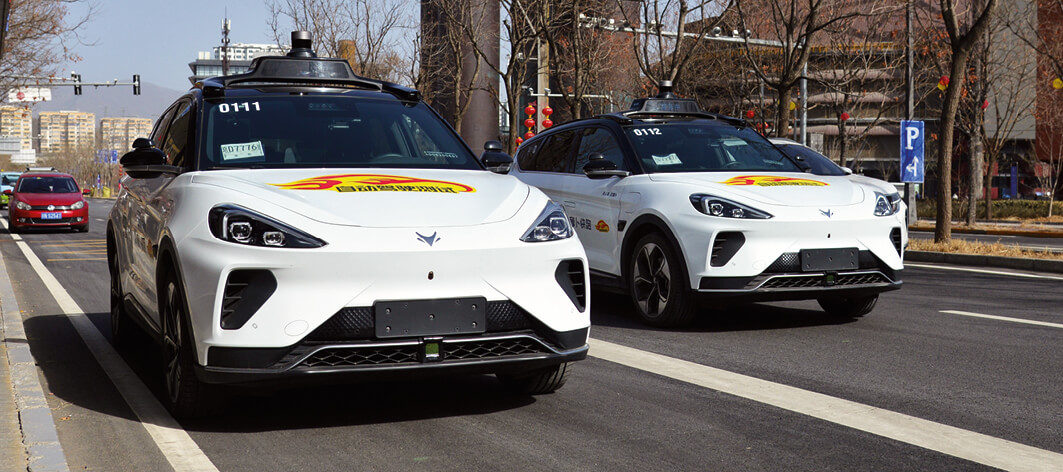The Czech Republic has decided to make significant progress on the path to autonomous mobility. The working group has prepared changes to the legislation that will allow the operation of Level 3 automated vehicles on selected roads. According to the amended sections of the Road Transport Act, the driver no longer has to be the one controlling the vehicle in all circumstances. He will also not always be responsible for any accidents. However, he must sit in the driver’s seat, be sober and wear a seat belt.
After a period when the attention of the automotive industry and the governments of individual European countries, especially the Czech Republic, was focused more on achieving the emission targets set by European Union legislation and the related effort to develop electromobility more quickly, including the construction of the necessary infrastructure, automated driving is once again coming into the spotlight.
It is not only a sexy topic that arouses enthusiasm (and perhaps even uncertainty) among both technical experts and the public, but also one of the main trends in transport, which should – after overcoming all the challenges – contribute not only to greater user comfort, but also to smoother traffic on the roads, and above all to a reduction in the number of traffic accidents. At the same time, it offers a number of opportunities for the private sector and for the creation of new transport solutions.
Achieving a state where truly independent automated vehicles of levels 4 and 5 will be common on the roads is still quite a long way off, but there is almost nothing preventing lower levels of automation. This is despite the fact that this is a very complex topic that needs to be resolved not only from a technical point of view, but also properly addressed legislatively.
“The EU does not yet have a comprehensive, unified framework for automated driving.”
“Although the initial optimism has been replaced by a certain sobering-up in a number of developed countries, many of them are further along in preparing the conditions for autonomous mobility than the Czech Republic,” admits automated mobility expert Ondřej Vaculín, a professor at the Technical University of Ingolstadt. “If we stay in Europe, then the winner is Germany, which started working on legislation in 2017 and in 2021 it was possible to approve the first serial automated vehicle for operation on land roads. It was a level 3 automated driving, i.e. a vehicle in which the driver does not have to monitor the traffic situation, but can, for example, watch a video on the infotainment. However, he must be ready to take over driving again at the request of the vehicle,” says Vaculín. Such vehicles cannot yet be legally operated in the Czech Republic due to the lack of legislation.

Ondřej Vaculín with the ANTON research automated vehicle, which has received an exemption for automated driving on roads in Germany. | Photo: Ondřej Vaculín archive
Domestic initiative
As for the Czech Republic, the first comprehensive overview of the measures that need to be implemented to enable autonomous vehicles to reach the roads was already included in the 2017 Action Plan on the Future of the Automotive Industry, which was part of the Memorandum on the Future of the Automotive Industry in the Czech Republic, signed between the Ministry of Industry and Trade and the Automotive Industry Association.
In April of this year, the Czech government presented a strategic document, the Autonomous Mobility Plan, which aims to create a favorable environment for the development and operation of automated vehicles in the country by 2025 with a vision to 2030. This initiative is intended to strengthen the position of the Czech Republic as a leader in research, development and testing of automated systems in Central Europe.
The plan outlines specific measures in four key areas: transport engineering, legislation, research and public education. It focuses on creating a testbed for automated vehicles, establishing a cybersecurity platform and developing a legal framework for automated operations at level 3. It supports research and innovation, encourages international cooperation and addresses ethical issues and accident investigations.
In addition, it aims to contribute to driver education, raise public awareness of autonomous mobility and ensure a skilled workforce in this area.
In addition to officials from the Ministry of Transport and the Ministry of Industry and Trade, a number of other stakeholders, including the Automotive Industry Association, are involved in solving individual tasks.
Challenges related to the introduction of fully autonomous vehicles on the roads
Technological and infrastructure challenges. Fully autonomous vehicles must be able to handle a wide range of situations without driver intervention, in any environment. Ensuring maximum safety is difficult, especially in complex urban environments with variable infrastructure and less predictable road users (pedestrians, cyclists). At the same time, the quality of both digital and physical infrastructure will need to be improved.
Legislative and regulatory barriers. Current national road traffic legislation is not prepared for autonomous vehicles. A globally harmonised legal framework for the deployment of fully autonomous vehicles would help reduce national implementation differences and accelerate the deployment of fully automated vehicles.
Societal and ethical issues. Public trust in fully autonomous vehicles is essential for the smooth adoption of this technology. At the same time, there is an ethical dilemma in the air about how vehicles should handle crisis situations (protection of passengers vs. other road users) while maintaining the principle of minimizing damage and consequences. The introduction of fully autonomous vehicles may also affect the labor market, especially in sectors such as transport (truck drivers, taxis, logistics).
Cybersecurity and privacy. Autonomous vehicles are at risk of cyberattacks because they are connected to the Internet and other external systems. Therefore, they need to be protected as much as possible. Regular software updates play a crucial role here, for which it will be necessary to ensure reliable mechanisms for their distribution and installation.
Legislative Working Group
At the end of 2023, a new working group was established to deal with the issue of automated vehicles from a legislative perspective. Its aim was to prepare a legislative amendment that would enable the operation of automated vehicles on land roads in the Czech Republic.
However, it should be emphasized that the preparation of legislation concerns systems that can partially and for a limited period of time take over the control of the vehicle (the aforementioned level 3, when the driver can hand over control to the vehicle for a limited period of time and on a selected section), not fully autonomous vehicles (level 5).
The participants in this working group were officials from several departments of the Ministry of Transport and the Police of the Czech Republic, representatives of TÜV SÜD, Škoda Auto, Valeo, SDA and others. A significant driver was again the Automotive Industry Association.
As Marie Nováková, AutoSAP’s Regulatory Affairs Manager, says, the working group has decided to take a minimalist approach at this point, i.e. to amend the existing legislation by implementing and amending paragraphs that will bring automated driving into line with the law. The use of automated vehicles on public roads requires an amendment to two laws, namely Act No. 361/2000 Coll. Act on Road Traffic (Road Traffic Act) and Act No. 56/2001 Coll. Act on the Conditions of Operation of Vehicles on Roads. After that, discussions will begin on the options for implementing the operation of vehicles with automation levels 4 and 5 into Czech legislation.
“The use of automated vehicles on public roads required the amendment of two laws.”
According to Ondřej Vaculín, the changes currently being made to the laws are not significant at first glance, but they are absolutely essential for the operation of autonomous vehicles.
The draft amendments to both laws have already passed the comment procedure and should now be in the Chamber of Deputies.
Who is the driver?
As for the driver, he does not need any further training to “drive” an automated vehicle. The method, conditions and rules of behavior of the control systems are described in the vehicle’s user manual. The only change for him is that at the moment the vehicle allows him to do so, he can hand over control to the vehicle and during this time he does not have to focus on driving.
In this context, the Road Traffic Act needs to define a driver so that it also includes a person who does not directly control the vehicle and only supervises it. The conditions are set by the vehicle manufacturer, or by the homologation regulation. The vehicle will not allow automated driving in bad weather or on roads where this is not permitted (current homologation regulations, for example, state that the system can only be activated on separate driving directions, where pedestrians and cyclists are excluded, i.e. on a motorway). The vehicle will monitor compliance with the conditions itself.
The new driver obligation for vehicles capable of automated driving is that they must be ready to take over the steering wheel at the request of the vehicle.
The fact that the driver does not have to drive under certain conditions does not mean that they are exempt from some of the other obligations that are currently in force. Even when driving autonomously, the driver must not be under the influence of alcohol and must be willing to undergo an alcohol test, must use seat belts, must not throw objects out of the car and their vehicle must have a registration plate.

A new generation of robotaxi (Arcfox Apollo Moon) is driving in Beijing, the result of a collaboration between Baidu and BAIC group. | Photo: Shutterstock.com
Levels of automated driving
Automated driving is divided into five levels that define the extent to which a vehicle can drive itself without driver intervention. These levels were established by SAE International (Society of Automotive Engineers), an organization that brings together professionals from the aerospace, automotive, and transportation industries.
Level 0 No automation / L0 No automation The driver performs all tasks, the car does not interfere with driving in any way, but may have warning and safety systems.
Level 1 Support systems / L1 Driver Assistance The car is equipped with one system that helps with driving. This can be a device that controls either the speed of the vehicle or its steering, such as adaptive cruise control or a lane keeping system. Everything else is done by the driver.
Level 2 Partial automation / L2 Partial automation The car has several systems that help with vehicle control (deceleration, acceleration, steering interventions), but the driver must monitor the surrounding environment and continue to focus on driving.
Level 3 Conditional automation / L3 Conditional automation The system is capable of automatic driving, i.e. it controls all elements necessary for driving. However, if necessary, the driver must be able to take over driving when prompted to respond to an unexpected situation.
Level 4 High automation / L4 High automation The car is capable of fully autonomous driving and does not require any intervention from the driver. However, this only applies to specific cases, such as driving on certain types of roads or in areas with necessary technical equipment. If conditions change, the driver must take over driving.
Level 5 Full automation / L5 Full automation A car (for example, a robot taxi) is capable of fully autonomous driving under all conditions on all roads. Theoretically, such a car does not need to be equipped with controls such as a steering wheel or pedals.
As the level of automation increases, the degree to which a vehicle can drive itself increases, but so do the demands on technology and safety systems. Fully autonomous vehicles (level 5) are still in the research and development stage.
Useful shortcuts
ACC Adaptive cruise control
ADAS Advanced driver assistance systems
AEBS Automatic emergency braking system
AVP Automated valet parking
DSSAD Data Storage System for Automated Driving
ELK Emergency lane-keeping
FCW Front collision warning
GSR General Safety Regulation
ISA Intelligent speed assistance
LKA Lane keeping assist
Sneaky liability
A key prerequisite for automated vehicles to be able to drive in the Czech Republic is the authority of the Czech Police to subject these vehicles to roadside checks in order to verify whether the driver or the vehicle was driving. This will usually be the case when the driver is suspected of committing an offense.
The Act on the Conditions of Operation of Vehicles on Land Roads will be amended so that the road vehicle register contains information that the registered vehicle is an automated vehicle according to European Union regulations. (The homologation process that each vehicle goes through before being put into service ensures that the technology in the vehicle is properly tested and approved across the full spectrum of declared functionalities and features according to EU standards.)
Among other things, by looking into the road vehicle register, inspection authorities will be able to promptly determine on the spot whether a vehicle is automated or not during a roadside inspection.
“It is crucial that the Czech Police also receive new powers.”
If it turns out that the vehicle is automated, the driver will be obliged to allow the inspection authorities access to the vehicle in order to verify whether or not he was driving, or whether or not the vehicle itself was driving. This obligation will also be specifically added to the Road Traffic Act. Detailed information about when the automated mode was activated by the driver is recorded in the DSSAD (Data Storage System for Automated Driving) system, in which it is not possible to change or delete the data in any way.
When the automated mode is not activated, the driver has full responsibility for driving, just as it is now. When the automated mode is activated, the vehicle takes over responsibility for driving. In this case, it will be up to further investigation whether the accident was caused by a malfunctioning system on the vehicle/vehicle manufacturer, or perhaps by the person in charge of the state of roads and road markings.
When it will be?
According to the members of the working group, if everything goes according to plan, the amendments to the laws could come into effect from the beginning of 2026.
“I consider the progress in the prepared legislation to be a significant breakthrough,” says Ondřej Vaculín, although he admits that in the next few decades autonomous vehicles will not become so common that they will push “regular” cars off the roads. In addition to technical and legislative aspects, he says that two more obstacles need to be overcome: ensuring acceptance by society, i.e. potential users, and reducing the final price of vehicles with these technologies.
Hands off, eyes on
While fully autonomous driving on the vast majority of public roads is currently not permitted by legislation, with a few exceptions (research vehicles, People Mover vehicles), there are an increasing number of vehicles that allow hands to be taken off the wheel even when driving at Level 2 – and for a significantly longer period than a few seconds.
Current Level 2 systems in most vehicles require the driver to have their hands on the wheel and pay full attention to the traffic. For example, the BMW 5 and 7 Series and the Ford Mustang Mach-E have come up with a hands off/eyes on system that allows driving up to 130 km/h on many roads without holding the steering wheel. However, the driver is obliged to continue to pay constant attention to what is happening on the road and to be able to take control again at any time.
A vehicle with this extended system can also change lanes without the driver having to grab the steering wheel. The driver initiates this lane change suggested by the system simply by looking longer into the exterior rearview mirror. If the adjacent lane is free, the vehicle will perform the maneuver.
The driver’s readiness to take over the steering wheel at any time is constantly monitored by a dedicated intelligent camera. The fundamental difference between higher levels of automated driving and this “superstructure” to level 2 is that the driver remains responsible for driving and for any accidents that may occur at any time.
Manufacturers must obtain the appropriate European permits for hands-off driving in individual countries. The driver can also drive the Mustang Mach-E without hands on the steering wheel in the Czech Republic. BMW currently only offers this option to drivers in Germany.
In Germany, level 3. 4 is also being prepared
Due to the already approved legislation, vehicles can also drive in automated driving mode level 3 in Germany, i.e. without hands on the steering wheel and the need to pay constant attention to the driving. These include some models from Mercedes (Drive Pilot highway assistant, which enables automated driving on divided, at least two-lane highways) or BMW (Personal Pilot system).
German legislators paved the way for Level 3 vehicles in 2017. Although the current approval regulations allow Level 3 vehicles to drive up to 130 km/h, currently there are vehicles on the market in Germany that have a speed limit in automated mode on highways of 60 km/h, suitable for driving in a platoon, and this year the technology for 95 km/h is coming.
However, German legislation goes even further than level 3. With the adoption of the Autonomous Driving Act (GAF) in 2021 and, above all, the Ordinance on the Authorization and Operation of Motor Vehicles with Autonomous Driving Function in Defined Operating Areas (AFGBV) from 2022, the conditions for the approval of Level 4 automated vehicles for operation are set. The Federal Road Authority (KBA) has developed processes and templates for creating documentation for the ordinance.
If someone wanted to drive in Germany in level 3 automated driving mode (this is not permitted in the Czech Republic), they would also have to buy a car that allows this in Germany. Interestingly, in Austria you can neither drive in nor buy such a car.
European legislative
EU GENERAL SAFETY REGULATION
The concept of automated vehicle is contained and defined in Regulation (EU) 2019/2144 of the European Parliament and of the Council of 27 November 2019 concerning type-approval requirements for motor vehicles and their trailers, and for systems, components and separate technical units intended therefor, with regard to general safety and the protection of vehicle occupants and vulnerable road users.
Implementing rules for Regulation (EU) 2019/2144 of the European Parliament and of the Council as regards uniform procedures and technical specifications for the type-approval of automated driving systems (ADS) for fully automated vehicles are laid down in Commission Implementing Regulation (EU) 2022/1426 of 5 August 2022.
According to Art. 3 point 21 of the EU General Safety Regulation, an “automated vehicle” is a motor vehicle designed and constructed to be able to move autonomously for a certain period of time, without constant driver supervision, but where driver intervention is nevertheless expected or required.
The resolution of the Global Forum on Road Safety issued in June 2022 recommends that drivers respond to a request to take dynamic control of the vehicle in an appropriate and timely manner and generally states that the driver should avoid performing activities other than driving that are not permitted by the version of the system installed in the vehicle by the manufacturer and where such activities prevent the taking of dynamic control after the request to take over has been issued.
It is appropriate to state for the sake of completeness that the EU General Safety Regulation also includes and defines the concept of “fully automated vehicle”, which is, according to Art. 3, point 22 of this regulation, a motor vehicle designed and manufactured in such a way that it can move autonomously, without any driver supervision. The current state of the relevant international and EU regulations, as well as progress in the development and production of these vehicles, do not provide a reason for the current solution to their operation on land roads, at least not in the Czech Republic.
UN REGULATION No. 157
From the point of view of the issue of approval of automated vehicles, the key international legal regulation is contained in particular in the regulation of the United Nations Economic Commission for Europe No. 157 entitled “Uniform provisions concerning the approval of vehicles with regard to the automated lane keeping system (ALKS), as amended.
This regulation regulates ALKS for vehicles of categories M and N, whereby this system is understood to be a system activated by the driver and keeping the vehicle within the current lane for travel speeds of 130 km/h and less, where the system controls the longitudinal and lateral movement of the vehicle for a longer period of time without the need for driver intervention. The application of UN Regulation No. 157 is then subject to binding references in the provisions of European Union law, in particular in the EU General Safety Regulation.
VIENNA CONVENTION
The development of autonomous driving is also responded to by the amended version of the Vienna Convention on Road Transport from 2022, where automatic driving technologies transferring driving tasks to the vehicle will be explicitly permitted in operation, provided that these technologies comply with UN vehicle regulations or can be taken over or switched off by the driver (see Article 8, paragraph 5bis). In the same year, Article 34bis was added to the Vienna Convention, which states that the requirement that every vehicle has a driver is considered to be met if the vehicle uses an automated driving system that complies with national technical regulations and applicable international law.
Contact
Next articles and interviews
Next articles and interviews
+ Show











